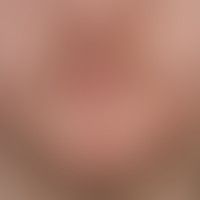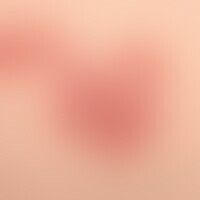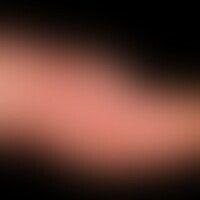Image diagnoses for "red"
901 results with 4543 images
Results forred

Acrodermatitis chronica atrophicans L90.4
Acrodermatitis chronica atrophicans: Symptoms existing for 1 year with an acral accentuated, inhomogeneous, blurred, edematous, red, rough swelling on the back of the right foot and extending to the lower leg in a 70 year old female patient.

Lymphomatoids papulose C86.6
Lymphomatoid papulosis: chronic, relapsing, completely asymptomatic clinical picture with multiple, 0.3 - 1.2 cm large, flat, scaly papules and nodules and ulcers.

Granuloma anulare disseminatum L92.0
Granuloma anulare disseminatum. general view: Non-painful, non-itching, disseminated, large plaques on the abdomen of a 43-year-old female patient. no diabetes mellitus.

Contact dermatitis allergic L23.0
Contact dermatitis allergic: large, blurred (scattered edges), itchy, red, rough, slightly scaly plaques that have been present for 4 weeks.

Vascular malformations Q28.88
Malformations vascular (non-syndromal, mixed, capillary/venous): Congenital vascular malformation, initially only imposing as a red spot, which showed constant thickness growth over the years, clinically asymptomatic (occasional increased bleeding when biting on it).

Atopic dermatitis (overview) L20.-
Eczema atopic (overview): flat eczematous infestation of the palms, hyperlinearity and lichenification, scratching effects.

Squamous cell carcinoma of the skin C44.-
Squamous cell carcinoma of the skin (lip carcinoma): ulcerated, broad-based, painless lump of the lower lip that has been growing slowly for several months; small basal cell carcinoma of the upper lip.

Mycosis fungoides plaque stage C84.0
Mycosis fungoides (plaque stage): 72-year-old male (sucking plaque stage of Mycosis fungoides); multiple, disseminated, 5.0-10.0 cm large, occasionally slightly itchy, only slightly consistency increased, slightly scaly red, poikilodermatic plaques are found.

Erythroplasia queyrat D07.4
erythroplasia. solitary, chronically dynamic, about 2 cm in size, sharply defined, clearly increased in consistency, symptom-free, red, smooth plaque. continuous growth since 1.5 years despite intensive local therapy. no healing after circumcision. laterally in the front a flat, rough, bizarrely defined white plaque (leukoplakia) is visible.

Erysipelas bullous
Erysipelas, bullous: acute , sharply limited, flat redness of the lower leg under high fever with extensive hemorrhagic blistering.

Infant haemangioma (overview) D18.01

Folliculitis barbae L73.8
Folliculitis barbae: Chronic therapy-resistant, inflammatory follicular papules and pustules in the area of the cheeks. front view of the finding.

Atopic dermatitis (overview) L20.-
eczema atopic in dark skin): here as partial manifestation of a generalized (face, neck, hands, lower leg and back of the foot) intrinsic atopic eczema Chronic brown-grey, blurred, itchy, rough plaques on lichenified skin.

Cheilitis granulomatosa G51.2
Cheilitis granulomtosa: Monosymptomatic orofacial granulomatosis. solitary, chronic, recurrent for months, clearly increased consistency, smooth swelling of the upper lip accompanied by a feeling of tension. no lingua plicata. no facial paresis.










